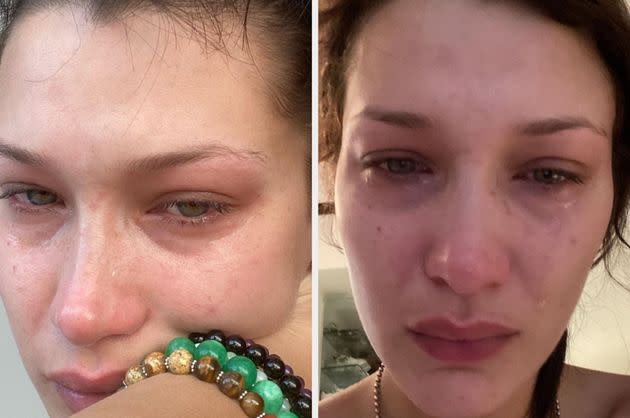Is The 'Crying Selfie' Good or Bad For Our Mental Health?

There’s sometimes a moment when you’re crying when you suddenly catch sight of yourself in the mirror. Or perhaps you consciously take a photo with your phone. Maybe you even send it to someone to show, without telling them, how you’re feeling.
It’s something supermodel Bella Hadid can attest to. The 25-year-old recently opened about the “excruciating and debilitating” anxiety she experiences and how “crying selfies” have helped her get through the pain.
Speaking to the Wall Street Journal, Hadid explained how these pictures bore witness to what she was enduring, and communicated her mental health troubles to her doctor and her mum.
She said: “My mom or my doctor would ask how I was and instead of having to respond in text, I would just send them a photo... I was never able to explain how I was feeling.”
She said sharing the images on Instagram also helped her feel less lonely.
Thankfully, a steady routine has helped Hadid overcome her depression while learning to manage her anxiety, the supermodel says.
Many of her fans have wished her well and commended her honesty. Others shared their own experiences of taking “crying selfies” . Some pointed out that revealing an intimate part of her life on an app where others often share life’s touched-up highlights was refreshing.
So, can crying selfies help during periods of mental low or are there other more effective ways to communicate your emotions?
Natasha Page, an accredited counsellor and psychotherapist with the British Association for Counselling and Psychotherapy says this communicative style can be good.
She tells HuffPost UK: “It’s great that Bella Hadid has found a way that she feels helps her to communicate her needs. Showing vulnerability can also be helpful for others who may struggle with their own mental health. However, not everyone feels as comfortable and at ease with expressing their emotions.”
Mental health is complex and some people struggle to seek help or speak out, she continues. “We are all unique individuals and we have differing ways of expressing ourselves. In this day of technology and social media we see people expressing and sharing things all the time but these are often the best bits of life. So if she finds comfort in being able to share her negative emotions in this way then good for her.”
When it comes to posting “crying selfies”, she does air a word of caution. “Sometimes when we are in heightened states of emotion such as anger or sadness we may act impulsively and this could result in posting something you may later regret, once things are out there on the internet it’s often too late to retract especially when in the public eye,” she says.
Page, who deals with patients experiencing mental health issues of their own, has a resource she offers them – My Little Therapy Box – which is designed to help people to explore areas of their lives that they are not feeling happy with or may be struggling with.
She also recommends other non-verbal ways of communicating, when it feels hard even with those nearest to you. “When working with families I have sometimes suggested having a safe object in the home which is placed somewhere in the house and if it is moved it means that the person is struggling and that they may need to talk. This can be effective for those who struggle to talk about their emotions but do want someone to know they are struggling.”
Anyone struggling with their mental health can seek help and support from a qualified and registered therapist – here is a guide to free talking therapy.
This article originally appeared on HuffPost UK and has been updated.




